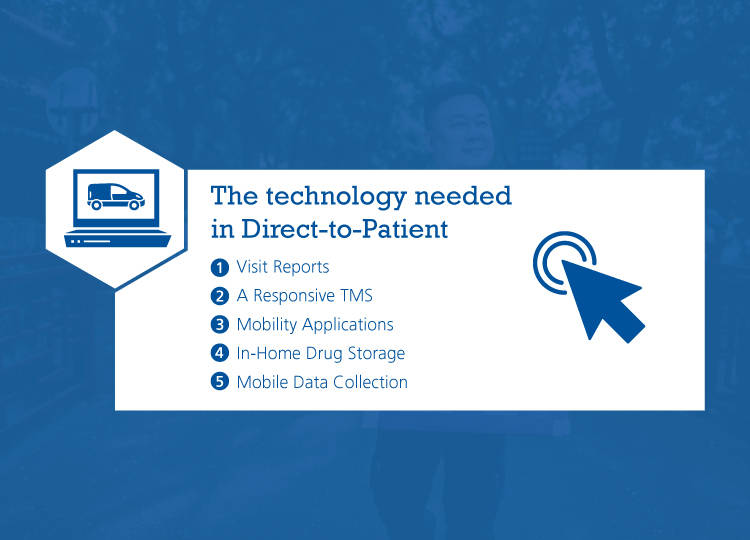Article: Direct-to-Patient Services: Solutions for Success
By David Spillett
All studies and therapeutic distribution programs are complicated, consisting of many moving parts. Direct-to-Patient (DtP) adds another dimension as external partners take on many of the responsibilities traditionally assumed by clinicians.
So what should you look for as you attempt to integrate DtP into your study or commercial delivery system? How can you ensure you have an appropriate degree of control once the study rolls out? How will you know you have selected the right partners?
1. Early engagement
Working with prospective partners early on is crucial in identifying potential pitfalls and finding practical solutions that address the nuances of the study – especially as they may apply to the DtP component.
Key questions to consider include:
- Which countries will be supporting the study?
- What are the specific regulatory requirements in those countries for nursing staff and logistics providers?
- What role does each partner play?
- What are the specific responsibilities of each partner? Have you optimized the services that will be performed in the home?
Working through this process early accrues important
benefits. At best, study parameters are reworked for greater efficiencies. At
worst, potential obstacles are identified before they can escalate.
Including all key stakeholders in the process and drawing on their expertise
streamlines planning and ensures that potential problems are handled as they
arise. Giving each partner a ‘voice’ in the process and allowing them to share
their experience will result in clearer direction on potentially contentious
issues. Over time, ongoing communication and collaboration between all partners
remains essential in ensuring that deliverables are achieved when the time
comes to execute. These efficiencies are certain to result in both time and
cost savings.
2. Technology
What technology-based products and services can help ensure appropriate oversight, conformity to the program design and the safety of patients?

Visit reports
On the nursing side, visit reports form the vital link between the in-home experience and the investigational site. Completed by the nurse at every visit, they allow the site to see exactly what the nurse sees. The form includes such information as vital signs, times of drug administration, adverse reactions, specimen details and other important data.
Mobile data collection
Today’s electronic tools make long-distance patient interface more efficient and effective as well. These include ECGs, cardiac monitors or pain management systems, as well as the capability to video-conference between physicians and patients or nurses and site staff.
A responsive TMS
Technology offers an equally important control mechanism on the logistics side where the transportation management system (TMS) lies at the heart of the operation. The TMS is where all shipment and scheduling data is captured, where all SOPs and work instructions are hosted, where all communications are centralized and where all administrative functions are coordinated. The system must be:
- Adaptable enough to support patient confidentiality modifications (using unique subject identity numbers instead of names to reference patients, for instance)
- Secure enough to offer global access to authorized parties (such as a single portal where all protocol details can be shared by client, sites and logistics provider)
- Robust enough to handle high volumes of detail (consider that, on average, over 600 patients participate in a phase 3 clinical trial[1] and every delivery variation must be documented)
- Nuanced enough to allow fine details to be quickly captured and relayed to the necessary parties (for example, dynamic dispatch/driver communications that relate to patient home deliveries or pick-ups)
Specialized clinical trial applications designed by the logistics provider and accessible by the study team, ensure that everyone has access to the same information in real time. Global access to internal protocols, SOPs and work instructions support the precise execution of regulatory, supply and procedural issues that can prevent costly shipping errors.
Mobility Applications
The success or failure of each DtP shipment relies on timely access to
information. Technology that permits the real-time relay of information between
driver, dispatch and operations helps ensure the error-free execution of every
shipment.
Detailed pre- and post-delivery checklists requiring
immediate driver confirmation, for instance, ensure that all instructions –
including those related to temp-controlled packaging and temperature monitoring
– have been followed to the letter. In the event of a deviation, immediate
communication between nurse and project manager allows office and sponsor
oversight as required. GPS supports on-time delivery especially during
start-up, rush-hour visits or for relief drivers.
In-Home Drug Storage
For patients located remotely or requiring frequent treatments, the study
team may consider storing medication at the patient’s home. Cubixx®CT is one
example of a small RFID-enabled refrigerator engineered for in-home storage of
sensitive drugs at 2°C - 8°C. Features include real-time remote temperature
monitoring, secured access, inventory management capabilities, alerts,
reporting and Web-portal access to track temperature and product usage.
Proven benefits have included improved patient adherence, a
reduction in medication waste, fewer home deliveries and improved nurse access
to medication. Meanwhile, sponsors and project teams retain improved control
and oversight of every location – reducing costs, time, errors and drug
accountability workloads in the process.
Engaging with external partners early and using technology to improve processes
and patient care will help you stay in control of the study and keep confidence
levels high. Find out what other solutions can influence your success– and more
about the Direct-to-Patient approach – in
our e-book:





.jpg?h=56&iar=0&w=56&useCustomFunctions=1¢erCrop=1&hash=5C3BF081DEFE0CD4643E0D660948B3B2)


